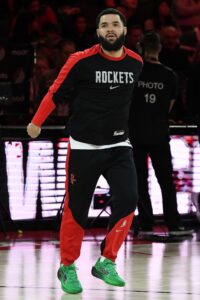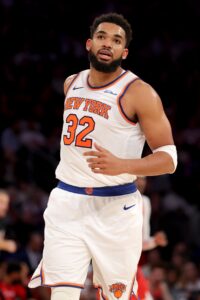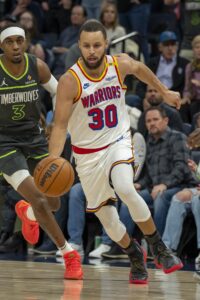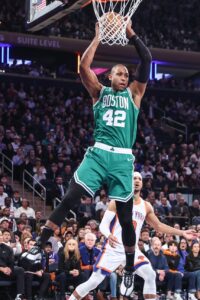The Rockets have just over $131MM in guaranteed money committed to player salaries for 2025/26. However, even though next season’s salary cap is expected to come in above $154MM, Houston won’t begin the 2025 offseason with $24MM+ in cap room to spend.
In fact, the Rockets technically won’t open the new league year with any cap space at all. Each of Houston’s own free agents will be assigned a free agent amount – or “cap hold” – until the player signs a new contract or the Rockets renounce his rights.
The general purpose of a cap hold is to prevent teams from using room under the cap to sign free agents before using Bird rights to re-sign their own free agents. If a team wants to take advantage of its cap space, it can renounce the rights to its own free agents, eliminating those cap holds. However, doing so means the team will no longer hold any form of Bird rights for those players — if the team wants to re-sign those free agents, it would have to use its cap room or another kind of cap exception.
The following criteria are used for determining the amount of a free agent’s cap hold:
- First-round pick coming off rookie contract: 300% of the player’s previous salary if prior salary was below league average; 250% of previous salary if prior salary was above league average.
- Bird player: 190% of previous salary (if below league average) or 150% (if above average).
- Early Bird player: 130% of previous salary.
- Non-Bird player: 120% of previous salary.
- Minimum-salary player: Two-year veteran’s minimum salary, unless the free agent only has one year of experience, in which case it’s the one-year veteran’s minimum.
- Two-way player: One-year veteran’s minimum salary.
A cap hold for a restricted free agent can vary based on his contract status. A restricted free agent’s cap hold is either his free agent amount as determined by the criteria mentioned above or the amount of his qualifying offer, whichever is greater.
 No cap hold can exceed the maximum salary for which a player can sign. For example, the cap hold for an Early Bird player with a salary above the league average is generally 130% of his previous salary, as noted above. But for an Early Bird player like Rockets guard Fred VanVleet, whose cap charge is $42,846,615 this season, 130% of his previous salary would be approximately $55.7MM, well beyond his projected maximum salary.
No cap hold can exceed the maximum salary for which a player can sign. For example, the cap hold for an Early Bird player with a salary above the league average is generally 130% of his previous salary, as noted above. But for an Early Bird player like Rockets guard Fred VanVleet, whose cap charge is $42,846,615 this season, 130% of his previous salary would be approximately $55.7MM, well beyond his projected maximum salary.
Instead, assuming VanVleet’s team option is declined by Houston, his cap hold would be equivalent to the maximum salary for a player with between seven and nine years of NBA experience. Based on a projected cap of $154,647,000, that figure works out to $46,394,100. If the Rockets turn down VanVleet’s option and intend to re-sign him, that cap hold would remain on their books until his new deal is official and his new cap hit replaces the hold.
One unusual case involves players on rookie contracts whose third- or fourth-year options are declined. The amount of their declined option becomes their cap hold, and if the player’s team wants to re-sign him, his starting salary can’t exceed that amount.
For instance, the Grizzlies declined Jake LaRavia‘s 2025/26 fourth-year option last fall, then traded him to the Kings in February. Because LaRavia’s rookie scale option was turned down, Sacramento won’t be able to offer him a starting salary this offseason worth more than $5,163,127, the amount of that option. That figure is also his cap hold.
That rule is in place so a team can’t circumvent the rookie scale and decline its option in an effort to give the player a higher salary. It applies even if the player is traded after his option is declined, but only to the club the player is part of at season’s end. In other words, because LaRavia finished the year with the Kings, Sacramento is prohibited from offering him a starting salary greater than $5,163,127 as a free agent, but any other team – including Memphis – could exceed that figure.
If a team holds the rights to fewer than 12 players, cap holds worth the rookie minimum salary are assigned to fill out the roster. So, even if a front office chooses to renounce its rights to all of its free agents and doesn’t have any players under contract, the team wouldn’t be able to fully clear its cap.
An incomplete roster charge in 2025/26 projects to be worth $1,272,870, meaning a team without any guaranteed salary or any other cap holds would have closer to $139MM in cap room than $154MM+ due to its 12 rookie minimum holds.
A player who has been selected in the draft but has not yet officially signed his rookie contract only has a cap hold if he was a first-round selection. A cap hold for a first-round pick is equivalent to 120% of his rookie scale amount, based on his draft position. An unsigned second-round pick doesn’t have a cap hold.
Cap holds aren’t removed from a team’s books until the player signs a new contract or has his rights renounced by the club. For example, the Warriors are still carrying cap holds on their books for retired players like Matt Barnes and David West, who never signed new contracts since playing for Golden State nearly a decade ago.
Keeping those cap holds gives teams some degree of cushion to help them remain above the cap and take advantage of the mid-level exception and trade exceptions, among other advantages afforded capped-out teams. If and when the Warriors want to maximize their cap room, they’ll renounce Barnes and West, but they’ve remained over the cap – and haven’t needed to remove those holds – since those players became free agents in 2017 and 2018, respectively.
Note: This is a Hoops Rumors Glossary entry. Our glossary posts will explain specific rules relating to trades, free agency, or other aspects of the NBA’s Collective Bargaining Agreement. Larry Coon’s Salary Cap FAQ was used in the creation of this post.
Earlier versions of this post were published in previous years by Luke Adams and Chuck Myron.
 Towns declined to elaborate on the injury when talking to reporters after the game. Reilly notes that he was able to remain on the court, although he shot just 5-of-18 in a 22-point loss to Boston.
Towns declined to elaborate on the injury when talking to reporters after the game. Reilly notes that he was able to remain on the court, although he shot just 5-of-18 in a 22-point loss to Boston. Curry, who suffered a
Curry, who suffered a  No cap hold can exceed the maximum salary for which a player can sign. For example, the cap hold for an Early Bird player with a salary above the league average is generally 130% of his previous salary, as noted above. But for an Early Bird player like Rockets guard
No cap hold can exceed the maximum salary for which a player can sign. For example, the cap hold for an Early Bird player with a salary above the league average is generally 130% of his previous salary, as noted above. But for an Early Bird player like Rockets guard  Nearly all of Boston’s core is under contract for multiple seasons beyond 2024/25. Veteran forward/center
Nearly all of Boston’s core is under contract for multiple seasons beyond 2024/25. Veteran forward/center